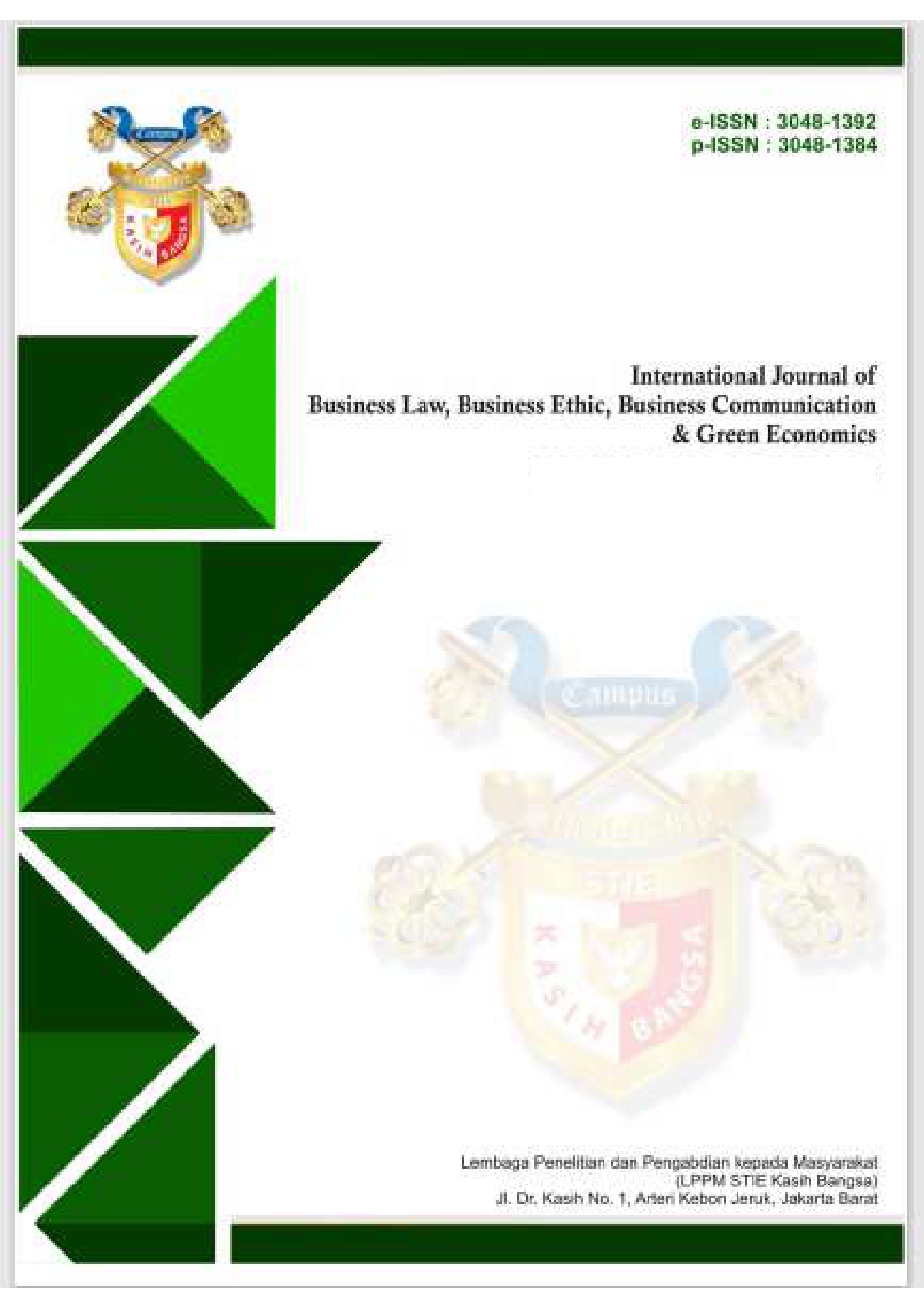Flexibility Production and Policy Credit Trading : Overview Theoretical to Influence Uncertainty Demand and Competition Among Suppliers
DOI:
https://doi.org/10.70142/ijbge.v2i2.340Keywords:
Production Flexibility, Trade Credit, Demand Uncertainty, Supplier Competition, Capital StructureAbstract
This qualitative literature review explores the impact of production flexibility on trade credit policy in the context of demand uncertainty and supplier competition. The findings show that production flexibility significantly affects the value and maturity of trade credit. Flexible firms tend to delay defaults, order larger quantities, and receive higher trade credit values. This flexibility allows firms to adjust their production capacity according to market changes, increasing their bargaining power in trade credit negotiations. In addition, production flexibility influences firms’ capital structure decisions and financial flexibility, which have a positive impact on trade credit policy. However, the proportion of trade credit to firm value is higher in less flexible firms. Although providing valuable insights, this study is limited by the existing literature and lacks empirical validation. Future research should test these findings empirically and explore industry-specific factors.
References
Adkins, R., & Paxson, D. (2012). Real input-output energy-switching options. The Journal of Energy Markets , 5(3), 3.
Aguerrevere , F.L. (2003). Equilibrium investment strategies and output price behavior : A real-options approach. The Review of Financial Studies , 16, 1239–1272.
Aguerrevere , F.L. (2009). Real options, product market competition, and asset returns. The Journal of Finance , 64, 957–983.
Altman, E., Resti , A., & Sironi, A. (2004). Default recovery rates in credit risk modeling: A review of the literature and empirical evidence. Economic Notes , 33(2), 183–208.
Amberg, N., Jacobson, T., von Schedvin , E., & Townsend, R. (2021). Curbing shocks to corporate liquidity: The role of trade credit. Journal of Political Economy , 129(1), 182–242.
Auboin , M., & Engemann, M. (2014). Testing the trade credit and trade link: Evidence from data on export credit insurance. Review of World Economics , 150, 715–743.
Biais , B., & Gollier, C. (1997). Trade credit and credit rationing. The Review of Financial Studies , 10(4), 903–937.
Binmore , K., Rubinstein, A., & Wolinsky, A. (1986). The Nash bargaining solution in economic modeling. RAND Journal of Economics , 17, 176–188.
Boell, S. K., & Cecez-Kecmanovic , D. (2015). On being 'systematic' in literature reviews in IS. Journal of Information Technology , 30(2), 161-173.
Brennan, M., Maksimovic, V., & Zechner , J. (1988). Vendor financing. Journal of Finance , 43(5), 1127–1141.
Brennan, M. J., & Schwartz, E. S. (1985). Evaluating natural resource investments. Journal of Business , 135–157.
Burkart, M., & Ellingsen, T. (2004). In-kind finance: A theory of trade credit. American Economic Review , 94(3), 569–590.
Cathcart, L., Dufour, A., Rossi, L., & Varotto , S. (2020). The differential impact of leverage on the default risk of small and large firms. Journal of Corporate Finance , 60, 101541.
Charalambides , M., & Koussis , N. (2018). A stochastic model with interacting managerial operating options and debt rescheduling. European Journal of Operational Research , 267, 236–249.
Chod, J., Lyandres , E., & Yang, S. A. (2019). Trade credit and supplier competition. Journal of Financial Economics , 131(2), 484–505.
Chod, J., Rudi, N., & Van Mieghem , J. A. (2010). Operational flexibility and financial hedging: Complements or substitutes? Management Science , 56(6), 1030–1045.
Correia, M., Kang, J., & Richardson, S. (2018). Asset volatility. Review of Accounting Studies , 23, 37–94.
Costello, A. M. (2013). Mitigating incentive conflicts in inter-firm relationships: Evidence from long-term supply contracts. Journal of Accounting and Economics , 56(1), 19–39.
Cuñat, V. (2007). Trade credit: Suppliers as debt collectors and insurance providers. Review of Financial Studies , 20(2), 491–527.
Dangl, T. (1999). Investment and capacity choice under uncertain demand. European Journal of Operational Research , 117(3), 415–428.
Dangl, T., & Zechner , J. (2021). Debt maturity and the dynamics of leverage. The Review of Financial Studies , 34(12), 5796–5840.
Deloitte. (2019). IFRS 9 financial instruments: Applying the expected credit loss model to trade receivables using a provision matrix .
https://www2.deloitte.com/cy/en/pages/risk/articles/ifrs-9-financial-instruments.html
Desai, M., Foley, C., & Hines, J. (2016). Trade credits and taxes. Review of Economics and Statistics , 98(1), 132–139.
Diamond, D. W., & He, Z. (2014). A theory of debt maturity: The long and short of debt overhang. The Journal of Finance , 69(2), 719–762.
Dichev , I.D., & Skinner, D.J. (2002). Large–sample evidence on the debt covenant hypothesis. Journal of Accounting Research , 40(4), 1091–1123.
Dixit, A., & Pindyck, R. (1994). Investment under uncertainty . Princeton University Press.
Dobbs, I.M. (2004). Intertemporal price cap regulation under uncertainty. The Economic Journal , 114, 421–440.
(2024). The Influence of Volatility Connection Bilateral Politics on Investment Decisions of Multinational Companies . Journal Business Innovative And Digital , 1(2), 01–13. https://doi.org/10.61132/jubid.v1i2.422
Ellingsen, T., Jacobson, T., & von Schedvin , E. (2016). Trade credit: Contract-level evidence contradicts current theories . Sveriges Riksbank Research Paper Series.
Emery, G. W. (1984). A pure financial explanation for trade credit. Journal of Financial and Quantitative Analysis , 19(3), 271–285.
Ericsson, J., Reneby , J., & Wang, H. (2015). Can structural models price default risk? Evidence from bond and credit derivative markets. Quarterly Journal of Finance , 5(3), 1–32.
Fabbri, D., & Klapper, L. (2016). Bargaining power and trade credit. Journal of Corporate Finance , 41(C), 66–80.
Ferrando, A., & Wolski, M. (2018). Investment of financially distressed firms: The role of trade credit . EIB Working Papers, No. 2018/04.
Ferris, J. S. (1981). A transactions theory of trade credit use. Quarterly Journal of Economics , 96(2), 243–270.
Fisman, R., & Love, I. (2003). Trade credit, financial intermediary development, and industrial growth. The Journal of Finance , 58(1), 353–374.
García- Appendini , E. (2011). Supplier certification and trade credit . Working Paper series, Bocconi University-IGIER.
Giannetti, M., Burkart, M., & Ellingsen, T. (2011). What you sell is what you lend? Explaining trade credit contracts. Review of Financial Studies , 24(4), 1261–1298.
Hackbarth, D., & Mauer, D. C. (2011). Optimal priority structure, capital structure, and investment. The Review of Financial Studies , 25(3), 747–796.
Hagspiel , V., Huisman, K., & Kort, P. (2016). Volume flexibility and capacity investment under demand uncertainty. International Journal of Production Economics , 178, 95–108.
Harris, C. (2015). Trade credit and financial flexibility. Banking & Finance Review , 7(1), 47–57.
Hu, Q., & Zhang, A. (2015). Real option analysis of aircraft acquisition: A case study. Journal of Air Transport Management , 46, 19–29.
Huberts, N. F., Huisman, K. J., Kort, P. M., & Lavrutich , M. N. (2015). Capacity choice in (strategic) real options models: A survey. Dynamic Games and Applications , 5(4), 424–439.
Hull, J., & White, A. (1995). The impact of default risk on the prices of options and other derivative securities. Journal of Banking & Finance , 19(2), 299–322.
Iancu, D. A., Trichakis , N., & Tsoukalas, G. (2017). Is operating flexibility harmful under debt. Management Science , 63(6), 1730–1761.
Ju, N., Parrino, R., Poteshman , A. M., & Weisbach, M. S. (2005). Horses and rabbits? Trade-off theory and optimal capital structure. Journal of Financial and Quantitative Analysis , 40(2), 259–281.
Kitchenham, B., & Charters, S. (2007). Guidelines for performing systematic literature reviews in software engineering . Technical report, EBSE Technical Report.
Klapper, L., Laeven , L., & Rajan, R. (2012). Trade credit contracts. The Review of Financial Studies , 25(3), 838–867.
Koussis , N., & Silaghi, F. (2020). Trade credit duration and optimal order quantities under buyer capacity constraints . Working Papers.
Koussis , N., & Silaghi, F. (2024). Production flexibility and trade credit under revenue uncertainty. Journal of Business Finance & Accounting .
https://doi.org/10.1111/jbfa.12786
Lee, Y. W., & Stowe, J. D. (1993). Product risk, asymmetric information, and trade credit. Journal of Financial and Quantitative Analysis , 28(2), 285–300.
Leland, H. (1994). Bond prices, yield spreads, and optimal capital structure with default risk (No. RPF-240). University of California at Berkeley.
Leland, H. E. (1998). Agency costs, risk management, and capital structure. The Journal of Finance , 53(4), 1213–1243.
Long, M. S., Malitz, I. B., & Ravid, A. (1993). Trade credit, quality guarantees, and product marketability. Financial Management , 22(4), 117–127.
Longstaff, F. A., & Schwartz, E. S. (1995). A simple approach to valuing risky fixed and floating rate debt. The Journal of Finance , 50(3), 789–819.
Lovreta , L., & Silaghi, F. (2020). The surface of implied firm's asset volatility. Journal of Banking & Finance , 112, 105253.
MacKay, P. (2003). Real flexibility and financial structure: An empirical analysis. Review of Financial Studies , 16, 1131–1165.
Mauer, D. C., & Sarkar, S. (2005). Real options, agency conflicts, and optimal capital structure. Journal of Banking & Finance , 29(6), 1405–1428.
McGuinness, G., Hogan, T., & Powell, R. (2018). European trade credit use and SME survival. Journal of Corporate Finance , 49, 81–103.
Mohamad Chaidir , Ngadi Permana , & Grace Yulianti. (2024). Disclosure Risk Cyber Security : The Impact To Connection Customer-Supplier In The Chain Corporate Supply . Journal of Management Vision , 10(3), 283–296. https://doi.org/10.56910/jvm.v10i3.586
Mohamad Chaidir , Grace Yulianti, & Benardi Benardi . (2024). Influence Volatility Equity and Leverage against Risk Investment . Journal of Management Vision , 10(1), 42–53. https://doi.org/10.56910/jvm.v10i1.556
Molina, C. A., & Preve, L. A. (2012). An empirical analysis of the effect of financial distress on trade credit. Financial Management , 41(1), 187–205.
Moody's. (2015). Annual default study: Corporate default and recovery rates , 1920–2014. Moody's Investors Service.
Ng, C., Smith, J., & Smith, R. (1999). Evidence on the determinants of credit terms used in interfirm trade. Journal of Finance , 54(3), 1109–1129.
Nishihara, M., Sarkar, S., & Zhang, C. (2019). Agency cost of debt overhang with optimal investment timing and size. Journal of Business, Finance & Accounting , 46(5–6), 784–809.
Petersen, M. A., & Rajan, R. G. (1997). Trade credit: Theories and Evidence. The Review of Financial Studies , 10(3), 661–691.
Rajan, R., & Zingales, L. (1995). What do we know about capital structure? Some evidence from international data. Journal of Finance , 50(5), 1421–1460.
Randall, C. (2021). Tesla upgrades Shanghai Gigafactory production capacities . https://www.electrive.com/2021/11/26/tesla-upgrades-shanghai-gigafactory-production-capacities/
Reinartz, S. J., & Schmid, T. (2016). Production flexibility, product markets, and capital structure decisions. The Review of Financial Studies , 29(6), 1501–1548.
Ritchken , P., & Wu, Q. (2021). Capacity investment, production flexibility, and capital structure. Production and Operations Management , 30(12), 4593–4613.
Ruslaini Ruslaini , & Eri Kusnanto . (2020). Sustainability in the Supply Chain Global Supply : An Overview Literature From a Business Perspective International and Management Chain Supply . Journal of Business, Finance, and Economics (JBFE), 1(2). https://doi.org/10.32585/jbfe.v1i2.5691
Sarkar, S. (2018). Optimal DOL (degree of operating leverage) with investment and production flexibility. International Journal of Production Economics , 202, 172–181.
Schwartz, R. (1974). An economic model of trade credit. Journal of Financial and Quantitative Analysis , 9(4), 643–657.
Shenoy, J., & Williams, R. (2017). Trade credit and the joint effects of supplier and customer financial characteristics. Journal of Financial Intermediation , 29, 68–80.
Silaghi, F., & Moraux , F. (2022). Trade credit contracts: Design and regulation, European Journal of Operational Research , 296(3), 980–992.
Silaghi, F., & Sarkar, S. (2021). Agency problems in public-private partnerships investment projects. European Journal of Operational Research , 290(39), 1174–1191.
Snyder, H. (2019). Literature review as a research methodology: An overview and guidelines. Journal of Business Research , 104, 333-339.
Strebulaev , I. A., & Yang, B. (2013). The mystery of zero-leverage firms. Journal of Financial Economics , 109(1), 1–23.
Tranfield , D., Denyer, D., & Smart, P. (2003). Towards a methodology for developing evidence‐informed management knowledge by means of systematic review. British Journal of Management , 14(3), 207-222.
Trigeorgis , L. (1996). Real options: Managerial flexibility and strategy in resource allocation . MIT press.
Webster, J., & Watson, R. T. (2002). Analyzing the past to prepare for the future: Writing a literature review. MIS Quarterly , 26(2), xiii-xxiii.
Yang, A., & Birge, J. (2018). Trade credit, risk sharing, and inventory financing portfolios. Management Science , 64(8), 3667–3689.
Yifan, Y. (2021). Tesla strikes new Panasonic battery deal as sales and shares soar . https://asia.nikkei.com/Business/Technology/Tesla-strikes-new-Panasonic-battery-deal-as-sales-and-shares-soar
Zhang, Z. (2019). Bank interventions and trade credit: Evidence from debt covenant violations. Journal of Financial and Quantitative Analysis , 54(5), 2179–2207.
















